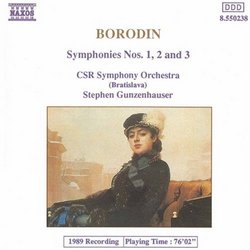| All Artists: Alexander Borodin, Stephen Gunzenhauser, Czecho-Slovak Radio Symphony Orchestra Title: Borodin: Symphonies 1-3 Members Wishing: 0 Total Copies: 0 Label: Naxos Release Date: 2/15/1994 Genre: Classical Styles: Historical Periods, Modern, 20th, & 21st Century, Symphonies Number of Discs: 1 SwapaCD Credits: 1 UPC: 730099523820 |
Search - Alexander Borodin, Stephen Gunzenhauser, Czecho-Slovak Radio Symphony Orchestra :: Borodin: Symphonies 1-3
 | Alexander Borodin, Stephen Gunzenhauser, Czecho-Slovak Radio Symphony Orchestra Borodin: Symphonies 1-3 Genre: Classical
|
Larger Image |
CD DetailsSimilar CDsSimilarly Requested CDs
|
CD ReviewsA Very Good Borodin Symphony Starter! Paul Rossi | Walla Walla, WA | 01/26/2004 (4 out of 5 stars) "A good friend of mine allowed me to borrow and listen to this CD. Borodin is one of my absolute favorite Russian composers, so I try to listen to as many different recordings of his symphonies as possible.To be perfectly honest, this CD holds up fairly well to the competition. Stephen Gunzenhauser and his Czech orchestra give very admirable, heartfelt performances of these great works. They play well in tune, are rhythmically coordinated, and are balanced well with one another. Gunzenhauser and the Slovak orchestra give very good performances of all three symphonies. However, due to some stiff competition, there are better recordings of these works with greater sonic output, better technical facility, and a greater sense of romanticism, contrast, and soul. Examples of this include the great budget recording of the Second Symphony by Ole Schmidt, Evgeny Svetlanov's recordings of these works, and (especially) the Neeme Jarvi box set of the Borodin symphonies, "In the Steppes of Central Asia," the "Petite Suite," and the famous Romance from Borodin's Second String Quartet.This said, you cannot beat these performances of the three Borodin Symphonies for this price. There is no comparison in the budget bracket. Plus, you get all the symphonies on only one CD. If you just want an introduction to the Borodin symphonies or want to supplement your existing collection, I recommend this CD without reservations. However, if you want the best performances available for quite a bit more money (and searching!), I recommend the Jarvi set." Rewarding Listening Leslie Richford | Selsingen, Lower Saxony | 02/13/2005 (4 out of 5 stars) "As with Tchaikovsky?s ?Manfred? symphony as performed by the same orchestra, I am forced to assume that one of the ?major? labels could probably have made an even better job of recording these works, the Naxos engineering being satisfactory but without the brilliance of some later productions. Stephen Gunzenhauser and the Slovak Radio Symphony Orchestra give an enthusiastic rendition of Borodin?s three symphonies, although I sometimes had the feeling that they could have done more to uncover the structures behind the works. The first symphony surprises by not sounding particularly Russian, except for occasional reminiscences of ?In the Steppes of Central Asia? or the overture to ?Prince Igor?. The second is much more Russian in flavor, but without in any way being ?folkloristic?. The third symphony was in quite an early stage of conception at Borodin?s untimely death, and Rimsky-Korsakov?s pupil Glazunov ?completed? it, using both piano and string quartet sketches by Borodin and his own memory, so that in the end you cannot really say what is Borodin and what is Glazunov. At all events, rewarding listening ? and thanks to Naxos for venturing beyond the narrow limits of the normal concert repertoire. Note written some time later: I have just heard the recording of these symphonies with the Gothenburg Symphony Orchestra directed by Neemi Järvi on Deutsche Grammophon. And I was right: the majors CAN do it better. There is a clarity and finesse here that the Gunzenhauser, good though it is, lacks." Borodin on a budget... vmzfla | Orlando, Fl. | 01/19/2007 (4 out of 5 stars) "For those on a budget this digital NAXOS entry of Borodin's 2.5 symphonies(the 3rd is unfinished)is a good value. Dabbling part time as a composer,
between reasearch and teaching chemistry. The Rimsky-Korsakov, Balakirev and Glazunov influenced Borodin created symphonies particularly nationalistically Russian. His first symphony took 5 years to complete and was his first sustained exercise in composition. It is a mixed bag with elements of German tradition, with parts criticized as "second hand" Schumann and Berlioz. There is a touch of what was to come in his exotic unfinished opera "Prince Igor". Both Glazunov and Rimsky-Korsakov tweaked the work considerably. The second symphony took 7 years to complete coinciding with his work on "Prince Igor" It is thoroughly Russian in mood. It's content is from the same pen that made the "Polovtsian Dances" so novel and approachable. This being one of my favorite symphonies. The two movement third was constructed by Glazunov from sketches of what were to be string quartets with a slight influence of a theme originally to be used in "Prince Igor". On a whole it is of a gentle mood. The engineers give us full blooded sound and the performance lacks only the last degree of refinement." |

 Track Listings (10) - Disc #1
Track Listings (10) - Disc #1









